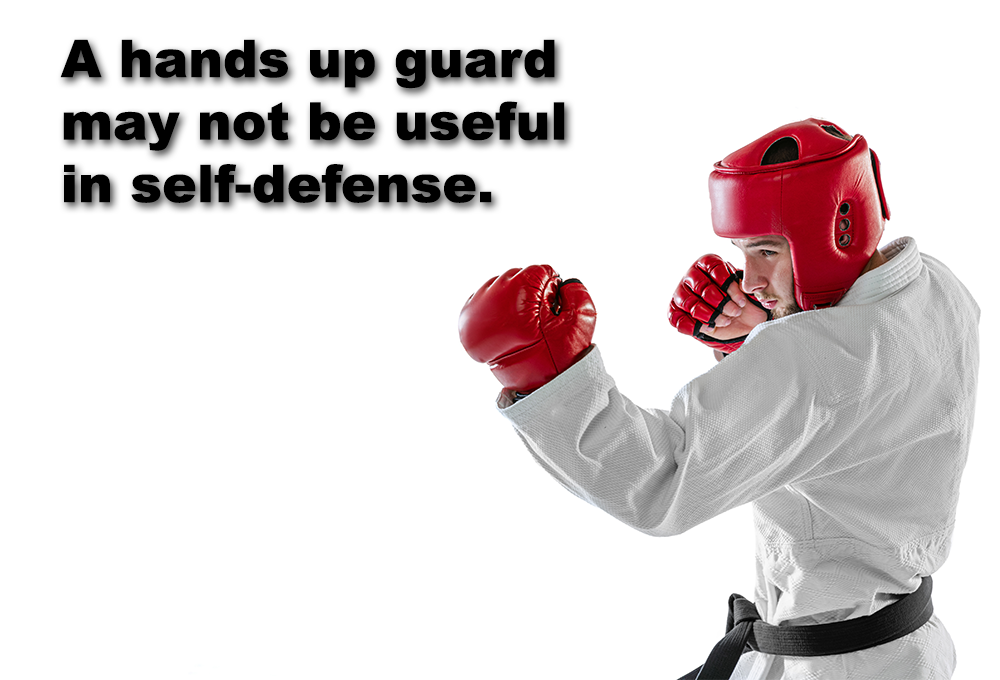
A hands up guard may not be useful in self-defense.
Posted by ADAM CARTER on OCT 7, 2022

A hands up guard may not be useful in self-defense.
In boxing we were taught the importance of a good, tight guard. When you put up a guard you’ve just consented to a fight.
Self-defense is different. In self-defense if you lift your hands and wait in your perfectly aligned tight guard, you’ve lost the initiative, the ability to surprise, and control the enemy’s limbs. It is a bad idea. It’s a bad move tactically and legally. (A street fight is illegal)
What we should do is subtlety control distance and lines of attack during the dialogue stages. We do this by tactically “talking with our hands” and subtlety / deceptively positioning our body. Guards have no role here. None.
The key is always what the context deems optimal.
A hands up guard is only useful in consensual fights. In self-protection you are so close that both hands should be working….. or you are far enough apart that you should be escaping.
There is no moving “back and forth”, no exchange of techniques, so the place where a guard is needed in a fight, does NOT exist in self-protection.
There’s a major difference between self-defense and fighting. In self-defense only the perpetrator wants to get into an altercation.
This is so important for practitioners and instructors alike to understand if your interest is in self-protection, and you are teaching self-defense to your students.
Guards are used in sparring when you are practicing consensual fighting skills, but in live close-range self-defense drills, the hands need to be actively clearing a path, or controlling, or locating the enemy. People can try to use a guard if they want, which in effect is allowing the attacker to have a go, to have a turn at attacking you, but you will quickly find it is not a good idea. Leaving a hand inactive like that causes problems.
You don’t want to allow the attacker to have a chance. You need to take control, and if your hands are up waiting for the exchange to happen, it will be too late. By the time you realize you are in a fight, it is already half over and you’ve taken three or four solid shots to the face, and your tee-shirt has been pulled over your head, rendering you blind.
The experience is jarring: unfiltered chaos, blurred vision in one eye from an errant thumb poke, a ringing eardrum from getting punched in the side of the head, the taste of your own blood, something in your throat as you swallow a tooth. It is disorganized, violent, confusion, and your heart rate is skyrocketing, with buckets of adrenaline dumped into your system.
You hold your breath as your body goes into shock and when it’s over, you throw up from exhaustion. The whole thing lasted less than 45 seconds. You’re battered, bruised, or worse….. All because you allowed the attacker a chance. Don’t give them this chance.
An actual fight is about survival. Any time that you have to think, is about the same amount of time it will take for your attacker to break your nose, knock you unconscious, stab you, or worse.
Generally from a reality based self-defense perspective there is no guard. By lifting your hands up in to a guard position you are inviting a fight. We do not want an exchange. We either want to escape on control the attacker. So there is no time to settle into a guard position, unless it is a consensual fight….. A consensual fight is not self-defense. Understand the difference.
With thanks to Iain Abernethy
![]() Photo Credit: Image by master1305 on Freepik
Photo Credit: Image by master1305 on Freepik
